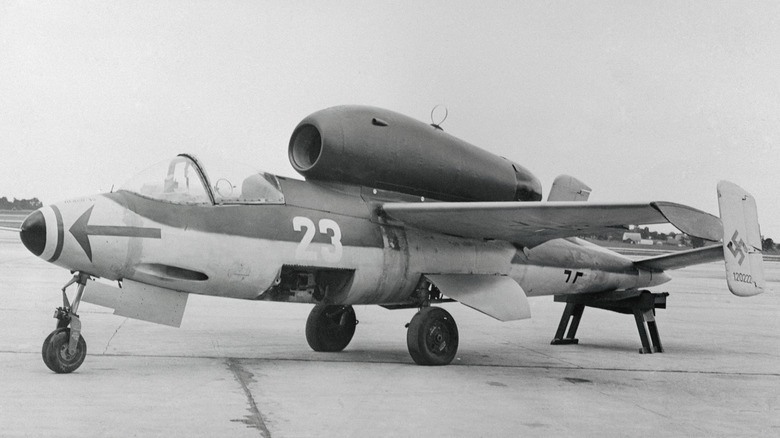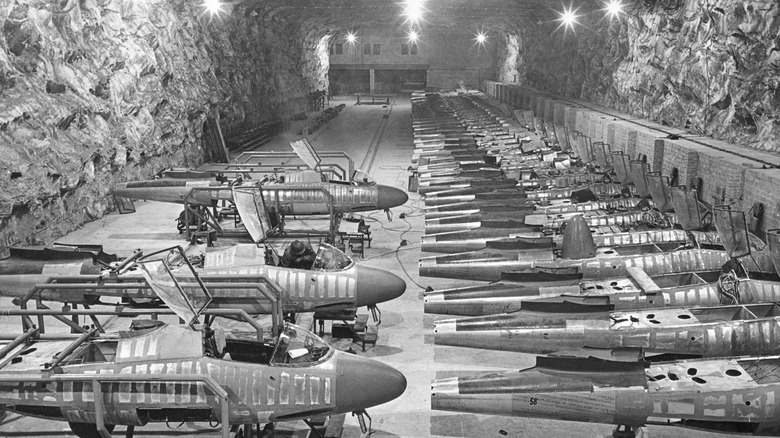Why This WW2 German Fighter Jet Was Destined To Fail
People don't intentionally set themselves up for failure, and things aren't deliberately built to malfunction. But when desperate times call for desperate measures, mechanical solutions that follow can be an abject disaster. Such is the case with the Germany military's Heinkel He 162 Volksjager (or the "People's Fighter"), the world's first operational single-engine jet fighter.
Colloquially, it was known as the Salamander in hopes of exuding the creature's fabled ability to withstand fire. And despite being called "one of the finest aircraft" one famous British test pilot ever flew, it has become more commonly known — perhaps mistakenly — as one of the worst fighter jets of all time.
The second World War was rife with critical moments that changed the war's outcome. One was when the Soviet Army drove back Adolf Hitler's attempt to seize Moscow in 1941. Another was during the summer of 1944 when the Allies broke through the German front in Poland. By the end of 1944 though, Allied bombers were relentlessly carpet-bombing Germany, and the Nazis were desperate to find a way to snatch back victory from the jaws of inevitable defeat.
On September 8, 1944, the German Ministry of Aviation ordered a massive fleet of cheap, maneuverable, single-engine jet fighters that could be flown with minimal training. The goal was to send them out in droves to take out Allied bombers. However, as evidenced by the Third Reich's unconditional surrender on May 7, 1945, things didn't go according to plan.
The Heinkel was built in record time
Some of the Volksjager's requirements were peculiar. According to Aviation History, it had to take off from a runway less than 1,640 feet long, couldn't weigh more than 4,400 pounds, and had to reach at least 466 mph at sea level. Additionally, it had to be capable of staying in the air for at least a half hour.
The military needed a test flight-ready prototype by Dec. 1, 1944, with a final design ready to go a month later. In short, they were asking for the impossible, as fielding a new aircraft usually took two to three years. Aluminum and other precious metals were also scarce and already committed to building other planes, so the Heinkel was made with wood and steel. For instance, a plywood nose capped the fuselage, and the single-piece wing was constructed out of wood but had metal-tipped winglets, which were changed while still on the production line to help minimize vibration. Overall, the plane was inherently unstable.
A single jet engine was placed on top instead of underneath because most runways at the time were grass fields where the intake could suck up all manner of debris and muck up the engine. The two wooden tailfins in the back were designed to keep the engine exhaust from igniting the wood. But the engine's placement caused a problem. If a pilot needed to extricate himself during flight, he would get sucked in. Thus, the Heinkel was equipped with one of the first ejector seats.
Don't blame the plane, blame the Germans
The Heinkel was equipped with the most basic instrumentation and controls because 16 and 17-year-old Hitlerjugend (Hitler Youth) with nominal glider training were meant to pilot them. In fact, the military expected these boys to fly the planes directly into the bombers if they couldn't shoot them down. The Nazis forced Jewish concentration camp prisoners to build the planes in their vast underground network of caves and bunkers. These slave laborers, working in poor conditions, didn't have the requisite skills to build airplanes, but they did have the motive to sabotage them whenever possible.
Lastly, cold and icy conditions caused several of these aircraft to disintegrate either mid-air or on landing as issues with the adhesive failed to hold the planes together. The plan was to manufacture 4,000 a month, but only 116 were fully built, though another 800 were incomplete. Very few were actually encountered in combat, and only seven survived the war.
The BMW 003 engine pushed the Heinkel to 522 miles per hour. Speed and instability seemed a recipe for disaster, but the shakiness wasn't the issue as all "the best fighter [planes]" were made unstable to dogfight. The real problem was the untrained boys piloting them. One of Britain's most famous test pilots, Capt. Eric Brown, said it was "very unforgiving" but also "a very stable gun platform," and if it'd been made in the numbers intended and flown by fully-trained pilots, would have been "a very formidable opponent."

